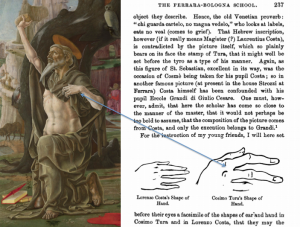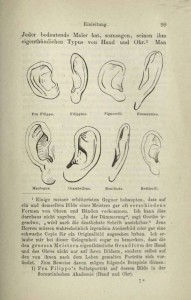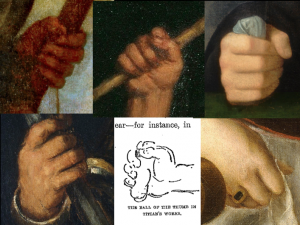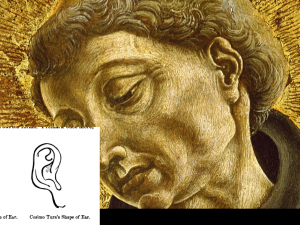On Giovanni Morelli, or How to See A Renaissance Painting Computationally – Christopher J. Nygren
On Giovanni Morelli, or How to See A Renaissance Painting Computationally
By Christopher J. Nygren
Giovanni Morelli is probably familiar to most art historians, though that’s not necessarily the case for computer scientists interested in computer-aided visual perception. In the late-nineteenth century Morelli published a series of interventions in Germans under the pseudonyms Ivan Lermolieff and Johannes Schwartze. Morelli’s proposal was radical and gave us what came to be known as the “Morellian method.” Morelli’s wager was that attention should be focused on the details of a picture rather than the “general impression” that it imparts to the beholder. Importantly, Morelli spoke only about painting, and attempts to broaden his method to encompass other artistic media have proven difficult.

At its core, the Morellian method is based on the belief that painters reveal their true identity in the places where they were expending the least attention – every painter wants to make sure that the Virgin’s face is beautiful, and that beauty generally follows a fairly generic pattern based on Western ideals of beauty. Painters reveal their true identity in other places, the parts of the painting about which they cared less – at least according to Morelli (figure 1).
Morelli pointed the viewer’s eye to places that uninitiated beholders are likely to overlook entirely. Anatomical features like fingernails, earlobe, toes and noses become for Morelli the locus of pictorial identity. This is why Morelli’s books appear so alien to art historians: rather than reproduce entire works of art, Morelli’s books just show collections of hands, ears, noses, etc. (figure 2).

The alienation, I think, is (at least) two-fold. Morelli’s first move is to excerpt what he takes to be the telling detail – nose, earlobe, fingernail… whatever it may be. But the second move is to offer a schematic rendering of that detail. I think it is fair to say that Morelli probably would have used photographic details if technology had allowed. As it stood, it was simply more practical to offer schematic line engravings. But there was some epistemological pushback in this technology, which forced Morelli not simply to recognize but to reproduce what he took to be the salient feature of the details he had singled out for heightened scrutiny. The process of mechanical reproduction was central to Morelli’s method because it allowed for the reduction of visual detail in order to focus on the essential. Moreover, his line engravings heightened contour and eliminated contrast, shading, tone, etc. Those are all of the other elements that make a painting a painting. Looking at his schematic rendering of a Titian hand next to high-resolution photos of some Titian hands, the schematic drawing seems entirely misguided (figure 3).

It lacked the tonal quality that makes a Titian a Titian… this is the man that was credited with his contemporaries for incarnating flesh on canvas using analogies to the Eucharist. To turn his pictures into schematic drawings is a kind of aesthetic violence that I think seems jarring to us now. But Morelli felt that it was justified if it facilitated the emergence of systematic understanding of the artist oeuvre.
This is what got me interested in Morelli’s connection to Computational Visual Aesthetics. His process – the Morellian Method – is something like algorithmic computation. It is an iterative procedure that draws attention to the minutia of a painting – fingernails, hair, ear lobes (figure 4) – in the hope of saying something of consequence about the whole. Like in DNA sequencing or computing programming, it is seeking to identify minimal degrees of variance that have maximal consequence.

I presented a version of this argument during the Computational Visual Aesthetics workshop and the participants seemed intrigued by the Morellian method. The art historians in the room were of course a bit skeptical about Morelli’s relevance. I joked that there seemed to be something “hipsterish” in the desire to revive the Morelli. But the participants with backgrounds in computer science seemed earnest in their curiosity. More than one asked the seemingly simple question: “does the method actually work?” As an art historian, that’s difficult to answer. Since the late nineteenth century we’ve learned a lot about how old master paintings were made. Michael Baxandall analyzed many contracts that show that patrons were fine having workshop assistants paint the less-important elements of a painting (things like fingernails), but were very keen on having “the Master” paint the important parts, like the face of the Virgin Mary, the body of Christ, etc. The fact is that most old master paintings are a collaborative effort between the “Master” and his assistants/apprentices. That’s a fact for which Morelli’s method does not account, and I tried to explain this as best I could.
But as the conversation continued I became more and more intrigued: would it be possible to put the Morellian method to the test and see how it performs? What would happen if we were able to query the entire ArtStor database looking for elements that are similar to what Morelli identified as a “Titian hand,” a “Cosmè Tura ear” or a “Raphael fingernail”? We grappled with this question throughout the day – in all honesty, I’m not sure what such an experiment might be able to tell us. Perhaps the query would return results that are entirely meaningless, but there is also a chance that it will return something that is useful. Perhaps the “utility” of this experiment for art historians would rest precisely in the process of trying to find meaning in the resultant dataset.
I think that art historians are probably justified in being skeptical of the suggestion that Morelli still has something to teach us. Morelli and his method cut hard against just about every trend currently visible in the discipline. And yet I am committed to the idea that the history of the discipline matters greatly, and that occasionally the dustbin of one discipline might contain a tool that is useful for another field of inquiry (think of the impact that certain of Gombrich’s writings have had outside of the field of art history). Might computer scientists be able to extract something useful from Morelli and his method? Or, perhaps more realistically, might an interdisciplinary exploration of Morelli’s method, its afterlife, and its utility serve as a training ground for collaboration between art historians and computer scientists interested in computer aided “vision”?
As became clear during the CVA workshop, there is a population of art historians and computer scientists who are invested in figuring out how to work productively across that disciplinary divide; it also became clear that there are many impediments to doing such work. While some are institutional, others are legitimate differences that cut to the core of disciplinary identities, modes of inquiry, and what constitutes a “deliverable” piece of scholarship. My hunch (or is it just a hope?) is that poking at Morelli’s method will provide something that is of interest to all parties involved. In doing so, I think that art Historians might be surprised to find that at the root of their discipline there exists a computation model for querying objects and images. Perhaps art historians have been doing something like “computational vision” all along, but we are only able to recognize this fact that that “vision” is itself put under scrutiny by the emergence of computer-aided perception. And perhaps computer-aided perception can be enhanced by recognizing that something similar is at the heart of art history as an academic discipline.
Christopher J. Nygren is Assistant Professor of Renaissance and Baroque Art History at the University of Pittsburgh. He can be reached at cnygren@pitt.edu.